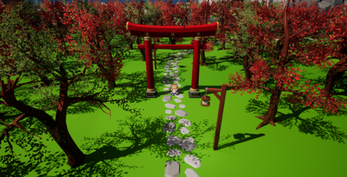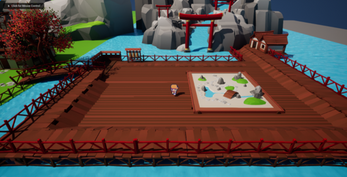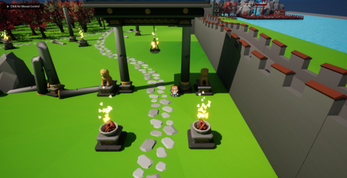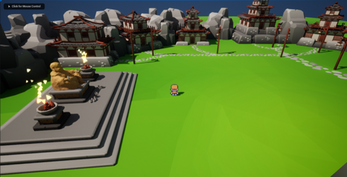Guiding Players Using Environmental Design
A downloadable project
1.0 Introduction
This project will be researching the psychology of players who play video games and how they utilize instincts over instructions to navigate through a linear level with multiple paths. We will be looking into what paths the users choose and why they chose those paths as they make their way from Point A to Point B. We will be investigating how the use of sound cues and visual cues can be utilized to try and navigate a player through the level without any other guidance to see how players respond to these cues and why they responded in that way.
1.1 Background
Many different factors can come into play when the player is responding to these cues, such as cultural impact and environmental impact, and how a player’s choice differs because of this – for example, in some parts of the world, the colour red may mean something different from danger, so this could affect the player’s choice if the bad path has red visual cues to try and deter a player. This research aims to identify and evaluate the ways a player’s mind works when responding to specific visual/audible cues, how unspoken guidance in video games can improve player immersion, and how the player’s experience differs.
1.2 Problem Statement
Past studies have provided valuable insights into how emotions, immersion, visual, and audible level design affect player choices in virtual scenarios. However, there is a lack of understanding regarding the reciprocal relationship between emotions and gameplay. Most research has focused on how the level design affects players’ emotions, rather than how these emotions influence their in-game choices. To develop more immersive games and effectively guide players without explicit instructions, it is crucial to investigate how player choices are affected by specific environmental cues and how these cues can trigger emotions that influence gameplay. This knowledge gap needs to be addressed to advance the fields of virtual reality and game design.
1.3 Research Question
How do visual and audio cues in environmental design elements, such as lighting, colour, and spatial layout, influence player behaviour, decision-making, and emotional responses in video games, and how effective are these cues in guiding players through a game level?
1.4 Aims and Objectives
Guiding players without detracting from immersion presents a significant challenge in game design, and it is an area that has not been extensively researched in comparison to other topics within the gaming industry. Studies have shown that techniques such as shifting elevation patterns and directional line patterns can strongly influence a player’s movement choices (Winters & Zhu, 2014).
The primary aim of this research is to explore the effectiveness of using visual and audio cues in guiding players through game levels without explicit instructions, with a particular focus on games that emphasize environmental design, such as survival horror games.
To achieve this aim, the research will pursue the following objectives:
- Investigate the types of visual and audio cues used in contemporary video games and their impact on player navigation and decision-making.
- Examine the role of environmental design in shaping player experiences and choices, especially in the context of survival horror games.
- Identify best practices for implementing visual and audio cues in game design to enhance immersion and guide players effectively without explicit instructions.
- Explore potential differences in the perception and use of visual and audio cues across demographic variables such as age, gender, and gaming platform preference.
By addressing these objectives, the research will contribute to a deeper understanding of the role of visual and audio cues in guiding players through immersive game environments and offer valuable insights for game designers seeking to optimize player experiences.
1.5 Scope and Limitations
The existing research demonstrates the importance of immersion and narrative in influencing a player’s emotional state when playing a game. For instance, a study conducted in Germany utilized virtual reality to examine emotional responses from players as they navigated a virtual environment (Freytag & Wienrich, 2017). This research complements earlier work in the United States that investigated the use of physiological signal analysis to design effective VR games, demonstrating the ability to induce measurable and distinguishable emotions from physiological signals (Li, Elmaghraby, El-Baz, & Sokhadze, 2015). These studies offer insights into how emotions and immersion can influence a player’s choices in virtual scenarios and highlight the significant role of both visual and audible level design in shaping these choices.
However, this research is subject to several limitations. First, the focus on immersion and narrative may not fully capture the impact of other factors, such as gameplay mechanics, on player choices. Second, the studies mentioned primarily involve virtual reality environments, which may not be directly applicable to traditional video game platforms. Third, the emotional responses and experiences of players could be highly individual and may not be generalizable to all players. Lastly, the research may not adequately address the influence of cultural differences in the perception and use of visual and audible cues in video games. Despite these limitations, the research provides valuable insights into the role of visual and audio cues in shaping player choices and experiences in video games.
1.6 Dissertation Structure
The remainder of this dissertation will be organized as follows: Chapter 2 presents a literature review, examining the current research on the use of sound and visual cues in video game design to guide players through the game. Chapter 3 discusses the methodology employed in this study, including research design, data collection, and data analysis. Chapter 4 presents case studies of two games that exemplify the use of environmental design to guide players. Chapter 5 provides a discussion of the findings, comparing techniques and strategies and evaluating the impact of environmental design on player experience. Finally, Chapter 6 concludes the dissertation with a summary of the findings, contributions to the field, recommendations for future research, and final remarks.






